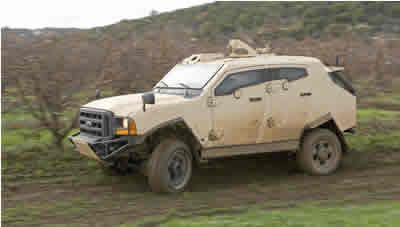Earlier in 2006 Defense Update had the opportunity to ride the new Sand Cat armored concept vehicle developed by Plasan Sasa. Traveling through dirt roads and fields of the mountains of the upper Galilee, just outside the Plasan’s R&D and production center at Kibbutz Sasa we appreciated the excellent handling and acceleration of the vehicle. Unlike noisy armored vehicles, this ride was surprisingly quiet. The six liter engine was humming along just normally, as we maneuvered the vehicle through steep and narrow roads of the Kibbutz, demonstrating extremely tight turns. We continued dashing at high speed on the perimeter road, and off-road, through fields, to demonstrate patrol missions profiles.

Throughout the ride, the vehicle demonstrated a quiet, soft ride, good road handling, and maneuverability using power steering and the torque-shift automatic 5 speed transmission, effectively managing the power to sustain a smooth ride, even over rough terrain and steep slopes. Adding to the comfort and confidence are significant power reserves of the V8, 325 hp turbo diesel (a gasoline powered version is also available for even quieter performance), leaving ample capacity for effective air conditioning. Despite the narrow side windows, sideways visibility was unobstructed, through the thick, transparent armored windows, while the bullet-proof one-piece windshield provided clear forward view. Compared to the claustrophobic experienced and hard rides experienced with some up-armored vehicles, and most armored personnel carriers, this compact armored vehicle is quite comfortable. It is fitted with Autoflug safety seats to further improve blast protection. These seats absorb the majority of impact forces in an event of a mine blast, improving the survivability of the crew. (The vehicle is also equipped with an integral fire suppression system in case a fire erupts after such explosion).
Equipped for long missions, the spacious internal volume leaves much space for mission and personal equipment. The original configuration uses an external baggage compartment and open cargo compartment, accessible from the protected hull via two access doors. The newly redesigned configuration uses internal stowage compartments and a full size access door, which can be lowered into a ramp. The hull can be configured to accommodate an open stretcher, loaded from the side or rear access doors. The wide, flat guards installed on each side of the vehicle enable placement for antennae mounts, eliminating the need for drilling into the armor.





















